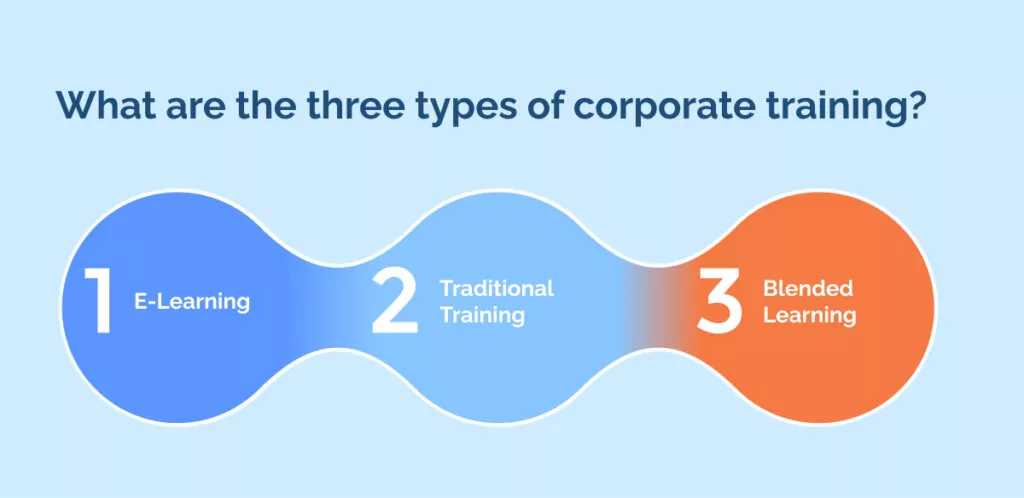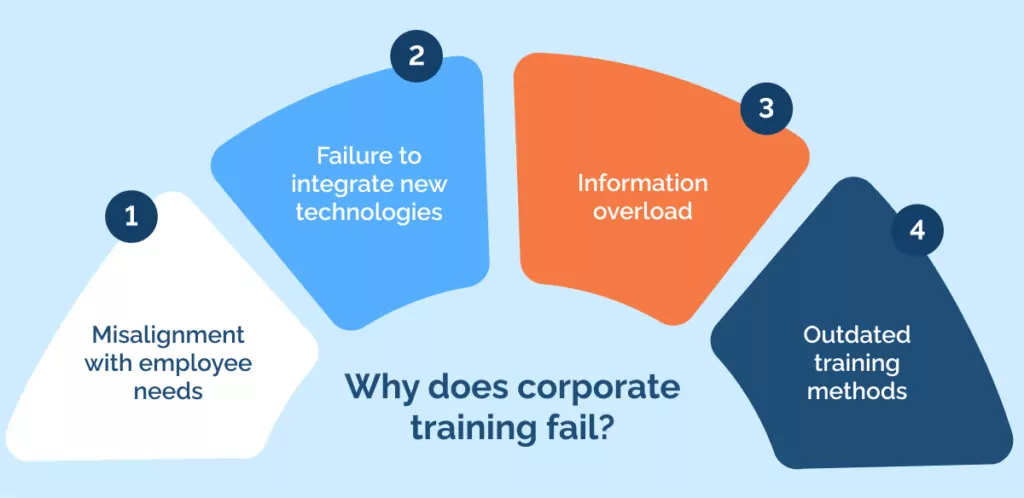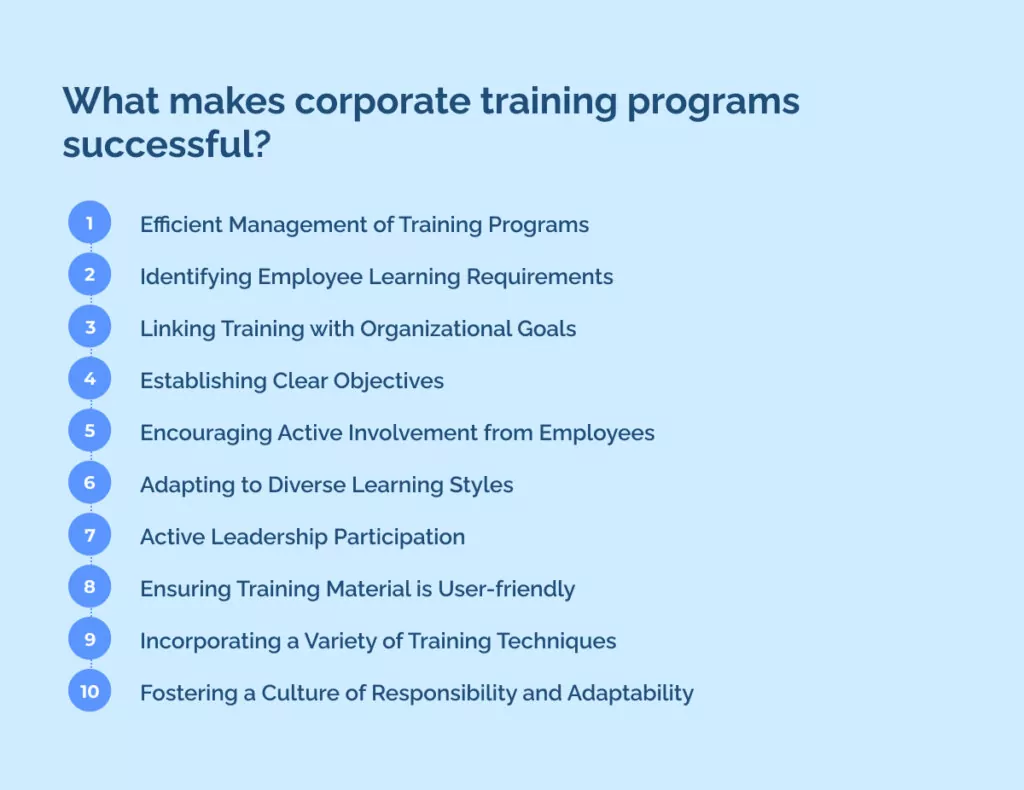
Corporate training, also known as corporate education or workplace learning, is a system of activities designed to educate employees.
This includes teaching them the knowledge and skills needed in their current job and preparing them for positions of greater responsibility. It can range from teaching specific job skills or tools to broader professional learning and development programs.
Effective corporate training is crucial for organizations to stay abreast of the latest industry trends, leading to enhanced business performance and increased employee productivity.
According to training solutions provider Lorman, 70% of employees would be somewhat likely to leave their current jobs to work for an organization known for investing in employee development and learning.
The same study also reveals that organizations with poor onboarding processes are twice as likely to experience employee turnover.
With that in mind, this article will explore the importance of corporate training and why it is crucial for both employees and organizations.
By the end of the article, you will understand:
- The benefits of corporate training for employees and organizations
- How corporate training can improve employee engagement and retention
- The role of technology in modern corporate training methods
What is corporate training?
Corporate training is a systematic approach to professional development activities provided to educate employees.
It encompasses various types of training programs, from leadership and soft skills training to technical and compliance training. The primary goal is to improve employees’ skills and knowledge, enhancing their performance and productivity.
Corporate training plays a critical role in keeping businesses competitive by ensuring employees are up-to-date with industry changes, new technologies, and market trends. It also boosts employee morale, job satisfaction, and loyalty, leading to lower turnover rates.
Moreover, it equips employees with the necessary skills and knowledge to excel in new positions and take on increased responsibilities, thereby promoting career advancement and ensuring a smooth transition of leadership within the organization.
Ultimately, corporate training is a strategic investment that fuels business growth and fosters long-term success.
Why is corporate training important?
Understanding the importance of corporate training is key to fostering a skilled, motivated, and adaptable workforce that drives business success.
Corporate training is important because it:
- Boosts employee morale and job satisfaction, resulting in higher retention rates.
- Prepares employees for new roles and responsibilities, promoting career growth.
- Fosters a culture of continuous learning and development, crucial for organizational success.
- Enhances employees’ competencies, leading to improved performance and increased productivity.
- Ensures the workforce stays updated with industry changes, new technologies, and trends, maintaining the company’s competitive edge.
Corporate training is not just an investment in the individual employee but also the overall health and future of the company.
What are the three types of corporate training?

In the past, corporate training was primarily conducted through in-person sessions and classroom-style workshops. However, with the advancement of technology, new methods of training have emerged.
There are three main types of corporate training:
- E-Learning: This is a digitized form of training delivery, often done through online courses, webinars, or digital workshops. It allows for flexibility in scheduling and pace and can be accessed from anywhere with an internet connection. E-learning often includes interactive elements like quizzes, videos, and discussion forums to enhance engagement.
- Traditional Training: Also known as Instructor-Led Training (ILT), this is the conventional face-to-face mode of training. It typically happens in a classroom setting with a trainer leading the session. Traditional training allows for real-time interaction, immediate feedback, and personalized instruction.
- Blended Learning: This combines the best of both e-learning and traditional training. It might involve initial online learning to cover theoretical aspects, followed by in-person sessions for practical application or discussion. Blended learning provides the convenience and flexibility of e-learning while maintaining the personal touch and interaction of traditional training.
Each type has its own strengths and suits different learning styles, objectives, and logistical considerations.
Why does corporate training fail?

Given the context of the fast-paced world we live in today, it’s no surprise that just 25% of participants in a recent McKinsey survey expressed confidence in the measurable improvement of performance through training.
Corporate training falls short in certain aspects. The issue lies in employees frequently failing to recognize the value of such training programs.
And we don’t blame them. Corporate training has become outdated and out of focus, with a huge proportion of employees actively avoiding training sessions at work. Employees have expressed the importance of increasing on-the-job training with a stronger emphasis on hands-on experience.
As innovative solutions like digital adoption platforms (DAPs) continue to emerge, effectively guiding employees through complex corporate training, now is a good time to explore the reasons behind corporate training failure.
Here are the top reasons why corporate training fails:
Misalignment with employee needs
Often, when employee needs aren’t met, and they feel like they aren’t being listened to, their engagement and capacity to learn will plummet.
Large corporations have a habit of overcomplicating corporate training to the extent that they fail to meet their employees’ most basic needs.
Businesses should prioritize and adopt a meticulous approach to meet the unique needs of their employees. One effective method is to audit internal employee processes, identifying and documenting pain points. This valuable information can then be addressed in future corporate training sessions, ensuring continual improvement and growth.
After completing the audit and ensuring your satisfaction with the results, you can leverage online surveys to target each business area specifically. Begin by sending the initial surveys to executives and managers, gradually working your way down the organizational hierarchy.
This approach allows you to assess the specific needs of each department, starting from the top and cascading downwards.
Remedy: Schedule a meeting with key decision-makers and present the findings from your audit. Collaborate to create a comprehensive training program tailored to meet the needs of various departments.
Failure to integrate new technologies
Technology has revolutionized corporate training, offering innovative solutions for learners to acquire knowledge and skills. However, the lack of integration of these technologies into existing training programs can lead to failure.
Software tools and digital platforms provide various features to enhance the learning experience, such as interactive simulations and real-time performance tracking. However, failure to integrate these technologies into corporate training programs can hinder employees from receiving the full benefits of modern training methods.
Emerging technologies such as artificial intelligence (AI), augmented reality, and virtual reality can potentially elevate corporate training, particularly in technical fields.
Remedy: Research and invest in emerging technologies to enhance the learning experience and improve employee performance. Conduct a thorough evaluation of potential software tools or platforms before integrating them into your corporate training program.
Information overload
We’ve all experienced it – being stuck in a tedious corporate training session, overwhelmed with excessive information that makes your head feel like it’s about to burst.
This approach is misguided, not only because it is dull but, more importantly, because it is overwhelming. Nobody enjoys feeling overwhelmed, especially in a professional setting where you are expected to perform at your highest level.
Businesses should invest in corporate training methods that are both proven and succinct.
Learning from your employees is a great way to overcome information overload. As previously stated, failure to align with employees’ needs can result in information overload, particularly if the corporate training provided is not relevant or focused.
Microlearning is also emerging as a solution for overzealous corporate training programs. It compartmentalizes complex training into easily digestible bite-sized chunks that employees have been proven to benefit from. The great thing about microlearning is that it can be consumed in many forms, including audio, video, infographics, job aides, games, or even text overlays.
Remedy: Introduce microlearning into your corporate training program. This bite-sized learning approach can be more engaging and effective, reducing information overload and improving knowledge retention.
Outdated training methods
Outdated training methods are without a doubt the worst offender in our opinion. One of the main reasons why corporate training fails is due to a lack of investment in innovative technology that enhances corporate training.
Digital transformation has a lot to do with this. Because businesses aren’t investing enough in digital-first initiatives, they are seeing their bottom line suffer as a result. Old manuals from the 90s don’t offer you the solutions you need in the fast-paced world of modern business.
By investing in organization-wide digital adoption initiatives that leverage solutions like digital adoption platforms (DAPs), businesses can streamline their focus and better address employee needs. This unlocks boundless productivity gains from highly focused and dedicated employees who recognize the benefits of their own training and development.
Lastly, gamification is also proving to be a great modern corporate training method. It combines graphical user interfaces (GUIs) and other game-like elements with traditional training materials to elevate the user experience (UX) by making it interactive.
According to a survey conducted by TalentLMS in 2019, 83% of employees who underwent game-like training reported feeling motivated. The survey also highlights that gamification positively impacted employee engagement and productivity, further emphasizing its effectiveness.
Remedy: Invest in innovative technologies and strategies like digital adoption platforms and gamification to modernize your corporate training program. Stay up-to-date with the latest trends and continuously evaluate and update your training methods to ensure they align with employee needs.
What makes corporate training programs successful?

Considering the potential challenges, creating a successful employee training program can feel overwhelming. Adding to the complexity, there isn’t a universally correct approach, with various factors shaping the structure and content of each company’s training program.
However, by carefully considering the following factors, you can develop a training program that effectively meets your company’s specific needs and goals:
- Efficient Management of Training Programs: This is about ensuring that all training activities are well-coordinated, organized, and geared towards achieving set objectives.
- Identifying Employee Learning Requirements: A thorough understanding of what employees need to learn is vital in crafting a successful training program.
- Linking Training with Organizational Goals: The training program should support the organization’s overall business objectives.
- Establishing Clear Objectives: Having clear goals for the training program helps provide direction and aids in measuring its effectiveness.
- Encouraging Active Involvement from Employees: The best corporate training programs motivate employees to actively participate and engage in learning activities.
- Adapting to Diverse Learning Styles: Trainers should be versatile and flexible enough to cater to various learning styles and preferences.
- Active Leadership Participation: Leaders must be involved in the training process, demonstrating their commitment to learning and development.
- Ensuring Training Material is User-friendly: The content of the training program should be easy to comprehend and absorb to facilitate maximum learning.
- Incorporating a Variety of Training Techniques: Utilizing different training approaches, like eLearning, can enrich the learning experience for employees.
- Fostering a Culture of Responsibility and Adaptability: Employees should be encouraged to apply what they’ve learned, and the training should promote adaptability to change.
What are the primary objectives of corporate training programs?

Corporate training serves several crucial purposes in the workplace. Now, let’s explore the key objectives that underpin corporate training and its significance.
The main goals of corporate training typically revolve around the following four aspects.
Skill Development
The primary goal of any training program is to enhance the skills and capabilities of employees, enabling them to excel in their roles and contribute to the organization’s success.
This can encompass many areas, including technical skills, such as proficiency in using specific software or equipment, and soft skills, such as effective communication, problem-solving, and leadership.
Additionally, industry-specific knowledge is crucial in equipping employees with the necessary expertise and understanding of the sector they operate in. Organizations that provide comprehensive and tailored training opportunities empower their workforce to develop and grow, fostering a culture of continuous learning.
Performance Improvement
Training programs are meticulously crafted with the objective of enhancing the overall performance and capabilities of employees in their respective roles.
Equipping individuals with the necessary skills, knowledge, and resources empowers them to excel in their tasks. This leads to a significant boost in productivity, efficiency, and the overall quality of work delivered.
Such training initiatives foster a culture of continuous improvement and professional development, ensuring that employees stay updated with the latest industry trends and best practices, thereby driving organizational effectiveness.
Employee Engagement and Retention
Well-structured and comprehensive training programs are crucial to organizations’ ability to retain their top talent.
Providing employees with opportunities for growth, skill development, and career advancement demonstrates the company’s commitment to their personal and professional success. These programs also foster a sense of engagement and investment among employees, making them feel valued and supported by their organization.
This, in turn, leads to increased job satisfaction, higher levels of productivity, and a stronger sense of loyalty towards the company. Organizations prioritizing well-structured training programs ultimately create a positive work environment that nurtures talent and fosters long-term success.
Compliance and Regulation
Especially in highly regulated industries, one of the primary goals of corporate training is to ensure that all employees are well-informed about and fully comply with the applicable laws and regulations that govern their respective fields.
Organizations can effectively mitigate potential risks and proactively prevent any potential legal issues from arising by providing comprehensive training programs that cover the nuances of legal requirements.
This safeguards the company’s interests and fosters a culture of compliance and accountability among employees.
How does corporate training affect career development?
Corporate training is a catalyst for career growth. It arms employees with the necessary skills for their present roles and future aspirations. Corporate training covers everything from tech skills to leadership acumen, from communication finesse to industry insights.
It’s not just about learning new skills; it’s about staying updated with industry shifts. With this continual learning, employees enhance their work efficiency and become an asset to any organization.
But it goes beyond that. When a company invests in corporate training, it sends a clear message – we value your growth. This boosts morale, engagement, and loyalty among employees.
Corporate training is more than just a tool. It’s a launchpad for career advancement, equipping employees with the resources they need to scale professional heights and fulfill their career ambitions.
What does the future hold for corporate training?
The landscape of corporate training is witnessing a transformative shift. Driven by technological advancements and changing workforce dynamics, the future of corporate training is set to be more personalized, immersive, and data-driven.
In the digital-first era, e-learning is expected to become even more prevalent. With the rise of artificial intelligence (AI) and machine learning (ML), we’ll see highly personalized training programs that adapt to individual learning styles, pace, and competency levels. These intelligent systems will analyze performance data to identify gaps in knowledge and tailor content accordingly, making learning more efficient and effective.
The integration of augmented reality (AR) and virtual reality (VR) into corporate training is on the horizon. These technologies offer immersive learning experiences, making complex concepts easier to understand and retain. Imagine an engineer virtually dismantling a machine to understand its workings or a manager practicing public speaking in a virtual auditorium. This ‘learning by doing’ approach enhances the practical application of skills.
Another trend shaping the future of corporate training is the focus on soft skills. With automation platforms taking over routine tasks, there’s a growing demand for skills like critical thinking, creativity, and emotional intelligence. Therefore, we can expect a surge in training programs that foster these competencies.
Finally, with remote work becoming the norm, mobile learning will play a crucial role, with training modules designed for easy access on smartphones and tablets, allowing employees to learn anytime, anywhere.
The future of corporate training is about harnessing technology to create engaging, relevant, and flexible learning experiences. It’s about empowering employees to take charge of their learning journey, keeping them ready for the challenges and opportunities of tomorrow.
WalkMe Team
WalkMe spearheaded the Digital Adoption Platform (DAP) for associations to use the maximum capacity of their advanced resources. Utilizing man-made consciousness, AI, and context-oriented direction, WalkMe adds a powerful UI layer to raise the computerized proficiency, everything being equal.



